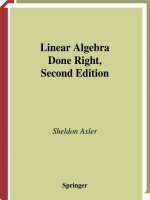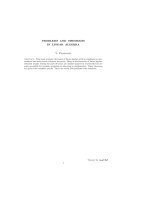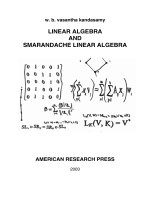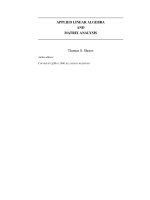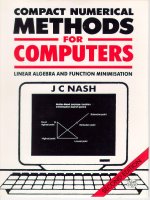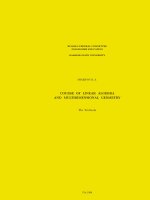Elementary linear algebra 9e howard anton rorres
Bạn đang xem bản rút gọn của tài liệu. Xem và tải ngay bản đầy đủ của tài liệu tại đây (18.04 MB, 1,226 trang )
P R E F A C E
This textbook is an expanded version of Elementary Linear Algebra, Ninth Edition, by Howard Anton. The first ten chapters of
this book are identical to the first ten chapters of that text; the eleventh chapter consists of 21 applications of linear algebra
drawn from business, economics, engineering, physics, computer science, approximation theory, ecology, sociology,
demography, and genetics. The applications are, with one exception, independent of one another and each comes with a list of
mathematical prerequisites. Thus, each instructor has the flexibility to choose those applications that are suitable for his or her
students and to incorporate each application anywhere in the course after the mathematical prerequisites have been satisfied.
This edition of Elementary Linear Algebra, like those that have preceded it, gives an elementary treatment of linear algebra that
is suitable for students in their freshman or sophomore year. The aim is to present the fundamentals of linear algebra in the
clearest possibleway; pedagogy is the main consideration. Calculus is not a prerequisite, but there are clearly labeled exercises
and examples for students who have studied calculus. Those exercises can be omitted without loss of continuity. Technology is
also not required, but for those who would like to use MATLAB, Maple, Mathematica, or calculators with linear algebra
capabilities, exercises have been included at the ends of the chapters that allow for further exploration of that chapter's
contents.
SUMMARY OF CHANGES
IN THIS EDITION
This edition contains organizational changes and additional material suggested by users of the text. Most of the text is
unchanged. The entire text has been reviewed for accuracy, typographical errors, and areas where the exposition could be
improved or additional examples are needed. The following changes have been made:
Section 6.5 has been split into two sections: Section 6.5 Change of Basis and Section 6.6 Orthogonal Matrices. This
allows for sharper focus on each topic.
A new Section 4.4 Spaces of Polynomials has been added to further smooth the transition to general linear
transformations, and a new Section 8.6 Isomorphisms has been added to provide explicit coverage of this topic.
Chapter 2 has been reorganized by switching Section 2.1 with Section 2.4. The cofactor expansion approach to
determinants is now covered first and the combinatorial approach is now at the end of the chapter.
Additional exercises, including Discussion and Discovery, Supplementary, and Technology exercises, have been added
throughout the text.
In response to instructors' requests, the number of exercises that have answers in the back of the book has been reduced
considerably.
The page design has been modified to enhance the readability of the text.
A new section on the earliest applications of linear algebra has been added to Chapter 11. This section shows how linear
equations were used to solve practical problems in ancient Egypt, Babylonia, Greece, China, and India.
www.pdfgrip.com
Hallmark Features
Relationships Between Concepts One of the important goals of a course in linear algebra is to establish the intricate
thread of relationships between systems of linear equations, matrices, determinants, vectors, linear transformations, and
eigenvalues. That thread of relationships is developed through the following crescendo of theorems that link each new
idea with ideas that preceded it: 1.5.3, 1.6.4, 2.3.6, 4.3.4, 5.6.9, 6.2.7, 6.4.5, 7.1.5. These theorems bring a coherence to
the linear algebra landscape and also serve as a constant source of review.
Smooth Transition to Abstraction The transition from
to general vector spaces is often difficult for students. To
smooth out that transition, the underlying geometry of
is emphasized and key ideas are developed in
before
proceeding to general vector spaces.
Early Exposure to Linear Transformations and Eigenvalues To ensure that the material on linear transformations
and eigenvalues does not get lost at the end of the course, some of the basic concepts relating to those topics are
developed early in the text and then reviewed and expanded on when the topic is treated in more depth later in the text.
For example, characteristic equations are discussed briefly in the chapter on determinants, and linear transformations from
to
are discussed immediately after
is introduced, then reviewed later in the context of general linear
transformations.
About the Exercises
Each section exercise set begins with routine drill problems, progresses to problems with more substance, and concludes with
theoretical problems. In most sections, the main part of the exercise set is followed by the Discussion and Discovery problems
described above. Most chapters end with a set of supplementary exercises that tend to be more challenging and force the
student to draw on ideas from the entire chapter rather than a specific section. The technology exercises follow the
supplementary exercises and are classified according to the section in which we suggest that they be assigned. Data for these
exercises in MATLAB, Maple, and Mathematica formats can be downloaded from www.wiley.com/college/anton.
About Chapter 11
This chapter consists of 21 applications of linear algebra. With one clearly marked exception, each application is in its own
independent section, so that sections can be deleted or permuted freely to fit individual needs and interests. Each topic begins
with a list of linear algebra prerequisites so that a reader can tell in advance if he or she has sufficient background to read the
section.
Because the topics vary considerably in difficulty, we have included a subjective rating of each topic—easy, moderate, more
difficult. (See “A Guide for the Instructor” following this preface.) Our evaluation is based more on the intrinsic difficulty of
the material rather than the number of prerequisites; thus, a topic requiring fewer mathematical prerequisites may be rated
harder than one requiring more prerequisites.
Because our primary objective is to present applications of linear algebra, proofs are often omitted. We assume that the reader
has met the linear algebra prerequisites and whenever results from other fields are needed, they are stated precisely (with
motivation where possible), but usually without proof.
Since there is more material in this book than can be covered in a one-semester or one-quarter course, the instructor will have
to make a selection of topics. Help in making this selection is provided in the Guide for the Instructor below.
Supplementary Materials for Students
Student Solutions Manual, Ninth Edition—This supplement provides detailed solutions to most theoretical exercises and to at
least one nonroutine exercise of every type. (ISBN 0-471-43329-2)
www.pdfgrip.com
Data for Technology Exercises is provided in MATLAB, Maple, and Mathematica formats. This data can be downloaded from
www.wiley.com/college/anton.
Linear Algebra Solutions—Powered by JustAsk! invites you to be a part of the solution as it walks you step-by-step through a
total of over 150 problems that correlate to chapter materials to help you master key ideas. The powerful online
problem-solving tool provides you with more than just the answers.
Supplementary Materials for Instructors
Instructor's Solutions Manual—This new supplement provides solutions to all exercises in the text. (ISBN 0-471-44798-6)
Test Bank—This includes approximately 50 free-form questions, five essay questions for each chapter, and a sample
cumulative final examination. (ISBN 0-471-44797-8)
eGrade—eGrade is an online assessment system that contains a large bank of skill-building problems, homework problems,
and solutions. Instructors can automate the process of assigning, delivering, grading, and routing all kinds of homework,
quizzes, and tests while providing students with immediate scoring and feedback on their work. Wiley eGrade “does the
math”… and much more. For more information, visit or contact your Wiley
representative.
Web Resources—More information about this text and its resources can be obtained from your Wiley representative or from
www.wiley.com/college/anton.
A GUIDE FOR THE
INSTRUCTOR
Linear algebra courses vary widely between institutions in content and philosophy, but most courses fall into two categories:
those with about 35–40 lectures (excluding tests and reviews) and those with about 25–30 lectures (excluding tests and
reviews). Accordingly, I have created long and short templates as possible starting points for constructing a course outline. In
the long template I have assumed that all sections in the indicated chapters are covered, and in the short template I have
assumed that instructors will make selections from the chapters to fit the available time. Of course, these are just guides and
you may want to customize them to fit your local interests and requirements.
The organization of the text has been carefully designed to make life easier for instructors working under time constraints: A
to
are
brief introduction to eigenvalues and eigenvectors occurs in Sections 2.3 and 4.3, and linear transformations from
discussed in Chapter 4. This makes it possible for all instructors to cover these topics at a basic level when the time available
for their more extensive coverage in Chapters 7 and 8 is limited. Also, note that Chapter 3 can be omitted without loss of
continuity for students who are already familiar with the material.
Long Template
Short Template
Chapter 1
7 lectures
6 lectures
Chapter 2
4 lectures
3 lectures
Chapter 4
4 lectures
4 lectures
Chapter 5
7 lectures
6 lectures
Chapter 6
6 lectures
3 lectures
www.pdfgrip.com
Long Template
Short Template
Chapter 7
4 lectures
3 lectures
Chapter 8
6 lectures
2 lectures
Total
38 lectures
27 lectures
Variations in the Standard Course
Many variations in the long template are possible. For example, one might create an alternative long template by following the
time allocations in the short template and devoting the remaining 11 lectures to some of the topics in Chapters 9, 10 and 11.
An Applications-Oriented Course
Once the necessary core material is covered, the instructor can choose applications from Chapter 9 or Chapter 11. The
following table classifies each of the 21 sections in Chapter 11 according to difficulty:
Easy. The average student who has met the stated prerequisites should be able to read the material with no help from the
instructor.
Moderate. The average student who has met the stated prerequisites may require a little help from the instructor.
More Difficult. The average student who has met the stated prerequisites will probably need help from the instructor.
EASY
MODERATE
MORE
DIFFICULT
1
2
ã
ã
3
4
5
6
7
8
9
10
11
12
ã
ã
ã
ã
ã
ã
ã
13
14
15
16
17
18
19
20
21
ã
ã
ã
ã
ã
ã
ã
Copyright â 2005 John Wiley & Sons, Inc. All rights reserved.
www.pdfgrip.com
•
•
•
•
•
A C K N O W L E D G E M E N T S
We express our appreciation for the helpful guidance provided by the following people:
REVIEWERS AND
CONTRIBUTORS
Marie Aratari, Oakland Community College
Nancy Childress, Arizona State University
Nancy Clarke, Acadia University
Aimee Ellington, Virginia Commonwealth University
William Greenberg, Virginia Tech
Molly Gregas, Finger Lakes Community College
Conrad Hewitt, St. Jerome's University
Sasho Kalajdzievski, University of Manitoba
Gregory Lewis, University of Ontario Institute of Technology
Sharon O'Donnell, Chicago State University
Mazi Shirvani, University of Alberta
Roxana Smarandache, San Diego State University
Edward Smerek, Hiram College
Earl Taft, Rutgers University
AngelaWalters, Capitol College
Mathematical Advisors
Special thanks are due to two very talented mathematicians who read the manuscript in detail for technical accuracy and
provided excellent advice on numerous pedagogical and mathematical matters.
Philip Riley, James Madison University
Laura Taalman, James Madison University
Special Contributions
The talents and dedication of many individuals are required to produce a book such as the one you now hold in your hands. The
following people deserve special mention:
www.pdfgrip.com
Jeffery J. Leader–for his outstanding work overseeing the implementation of numerous recommendations and improvements
in this edition.
Chris Black, Ralph P. Grimaldi, and Marie Vanisko–for evaluating the exercise sets and making helpful recommendations.
Laurie Rosatone–for the consistent and enthusiastic support and direction she has provided this project.
Jennifer Battista–for the innumerable things she has done to make this edition a reality.
Anne Scanlan-Rohrer–for her essential role in overseeing day-to-day details of the editing stage of this project.
Kelly Boyle and Stacy French–for their assistance in obtaining pre-revision reviews.
Ken Santor–for his attention to detail and his superb job in managing this project.
Techsetters, Inc.–for once again providing beautiful typesetting and careful attention to detail.
Dawn Stanley–for a beautiful design and cover.
The Wiley Production Staff–with special thanks to Lucille Buonocore, Maddy Lesure, Sigmund Malinowski, and Ann Berlin
for their efforts behind the scenes and for their support on many books over the years.
HOWARD ANTON
CHRIS RORRES
Copyright © 2005 John Wiley & Sons, Inc. All rights reserved.
www.pdfgrip.com
1
C H A P T E R
Systems of Linear Equations and Matrices
I N T R O D U C T I O N : Information in science and mathematics is often organized into rows and columns to form rectangular arrays,
called “matrices” (plural of “matrix”). Matrices are often tables of numerical data that arise from physical observations, but they also
occur in various mathematical contexts. For example, we shall see in this chapter that to solve a system of equations such as
all of the information required for the solution is embodied in the matrix
and that the solution can be obtained by performing appropriate operations on this matrix. This is particularly important in
developing computer programs to solve systems of linear equations because computers are well suited for manipulating arrays of
numerical information. However, matrices are not simply a notational tool for solving systems of equations; they can be viewed as
mathematical objects in their own right, and there is a rich and important theory associated with them that has a wide variety of
applications. In this chapter we will begin the study of matrices.
Copyright © 2005 John Wiley & Sons, Inc. All rights reserved.
www.pdfgrip.com
1.1
INTRODUCTION TO
SYSTEMS OF LINEAR
EQUATIONS
Systems of linear algebraic equations and their solutions constitute one of the
major topics studied in the course known as “linear algebra.” In this first section
we shall introduce some basic terminology and discuss a method for solving such
systems.
Linear Equations
Any straight line in the
-plane can be represented algebraically by an equation of the form
where , , and b are real constants and and are not both zero. An equation of this form is called a linear equation in the
variables x and y. More generally, we define a linear equation in the n variables , , …,
to be one that can be expressed in the
form
where
,
, …,
EXAMPLE 1
, and b are real constants. The variables in a linear equation are sometimes called unknowns.
Linear Equations
The equations
are linear. Observe that a linear equation does not involve any products or roots of variables. All variables occur only to the first
power and do not appear as arguments for trigonometric, logarithmic, or exponential functions. The equations
are not linear.
A solution of a linear equation
satisfied when we substitute
,
, …,
sometimes the general solution of the equation.
EXAMPLE 2
is a sequence of n numbers , , …, such that the equation is
. The set of all solutions of the equation is called its solution set or
Finding a Solution Set
Find the solution set of (a)
, and (b)
.
Solution (a)
To find solutions of (a), we can assign an arbitrary value to x and solve for y, or choose an arbitrary value for y and solve for x. If
we follow the first approach and assign x an arbitrary value t, we obtain
These formulas describe the solution set in terms of an arbitrary number t, called a parameter. Particular numerical solutions can be
www.pdfgrip.com
obtained by substituting specific values for t. For example,
,
yields the solution
,
; and
yields the solution
.
If we follow the second approach and assign y the arbitrary value t, we obtain
Although these formulas are different from those obtained above, they yield the same solution set as t varies over all possible real
numbers. For example, the previous formulas gave the solution
,
when
, whereas the formulas immediately above
yield that solution when
.
Solution (b)
To find the solution set of (b), we can assign arbitrary values to any two variables and solve for the third variable. In particular, if
we assign arbitrary values s and t to and , respectively, and solve for , we obtain
Linear Systems
A finite set of linear equations in the variables , , …,
is called a system of linear equations or a linear system. A sequence
,
, …,
is a solution of every equation in the
of numbers , , …, is called a solution of the system if
system. For example, the system
has the solution
,
,
since these values satisfy both equations. However,
solution since these values satisfy only the first equation in the system.
,
,
is not a
Not all systems of linear equations have solutions. For example, if we multiply the second equation of the system
by
, it becomes evident that there are no solutions since the resulting equivalent system
has contradictory equations.
A system of equations that has no solutions is said to be inconsistent; if there is at least one solution of the system, it is called
consistent. To illustrate the possibilities that can occur in solving systems of linear equations, consider a general system of two
linear equations in the unknowns x and y:
The graphs of these equations are lines; call them and . Since a point (x, y) lies on a line if and only if the numbers x and y
satisfy the equation of the line, the solutions of the system of equations correspond to points of intersection of and . There are
three possibilities, illustrated in Figure 1.1.1:
www.pdfgrip.com
Figure 1.1.1
The lines
and
may be parallel, in which case there is no intersection and consequently no solution to the system.
The lines
and
may intersect at only one point, in which case the system has exactly one solution.
The lines and may coincide, in which case there are infinitely many points of intersection and consequently infinitely
many solutions to the system.
Although we have considered only two equations with two unknowns here, we will show later that the same three possibilities hold
for arbitrary linear systems:
Every system of linear equations has no solutions, or has exactly one solution, or has infinitely many solutions.
An arbitrary system of m linear equations in n unknowns can be written as
www.pdfgrip.com
where , , …,
are the unknowns and the subscripted a's and b's denote constants. For example, a general system of three
linear equations in four unknowns can be written as
The double subscripting on the coefficients of the unknowns is a useful device that is used to specify the location of the coefficient
in the system. The first subscript on the coefficient
indicates the equation in which the coefficient occurs, and the second
is in the first equation and multiplies unknown .
subscript indicates which unknown it multiplies. Thus,
Augmented Matrices
If we mentally keep track of the location of the +'s, the x's, and the ='s, a system of m linear equations in n unknowns can be
abbreviated by writing only the rectangular array of numbers:
This is called the augmented matrix for the system. (The term matrix is used in mathematics to denote a rectangular array of
numbers. Matrices arise in many contexts, which we will consider in more detail in later sections.) For example, the augmented
matrix for the system of equations
is
Remark When constructing an augmented matrix, we must write the unknowns in the same order in each equation, and the
constants must be on the right.
The basic method for solving a system of linear equations is to replace the given system by a new system that has the same solution
set but is easier to solve. This new system is generally obtained in a series of steps by applying the following three types of
operations to eliminate unknowns systematically:
1. Multiply an equation through by a nonzero constant.
2. Interchange two equations.
3. Add a multiple of one equation to another.
Since the rows (horizontal lines) of an augmented matrix correspond to the equations in the associated system, these three
operations correspond to the following operations on the rows of the augmented matrix:
1. Multiply a row through by a nonzero constant.
www.pdfgrip.com
2. Interchange two rows.
3. Add a multiple of one row to another row.
Elementary Row Operations
These are called elementary row operations. The following example illustrates how these operations can be used to solve systems
of linear equations. Since a systematic procedure for finding solutions will be derived in the next section, it is not necessary to
worry about how the steps in this example were selected. The main effort at this time should be devoted to understanding the
computations and the discussion.
EXAMPLE 3
Using Elementary Row Operations
In the left column below we solve a system of linear equations by operating on the equations in the system, and in the right column
we solve the same system by operating on the rows of the augmented matrix.
Add −2 times the first equation to the second to obtain
Add −2 times the first row to the second to obtain
Add −3 times the first equation to the third to obtain
Add −3 times the first row to the third to obtain
Multiply the second equation by
Multiply the second row by
to obtain
to obtain
Add −3 times the second equation to the third to obtain
Add −3 times the second row to the third to obtain
Multiply the third equation by − 2 to obtain
Multiply the third row by −2 to obtain
www.pdfgrip.com
Add −1 times the second equation to the first to obtain
Add −1 times the second row to the first to obtain
Add
Add
times the third equation to the first and
times the
third equation to the second to obtain
The solution
,
,
third row to the second to obtain
is now evident.
Exercise Set 1.1
Click here for Just Ask!
Which of the following are linear equations in
times the third row to the first and
,
, and
?
1.
(a)
(b)
(c)
(d)
(e)
(f)
Given that k is a constant, which of the following are linear equations?
2.
www.pdfgrip.com
times the
(a)
(b)
(c)
Find the solution set of each of the following linear equations.
3.
(a)
(b)
(c)
(d)
Find the augmented matrix for each of the following systems of linear equations.
4.
(a)
(b)
(c)
(d)
Find a system of linear equations corresponding to the augmented matrix.
5.
www.pdfgrip.com
(a)
(b)
(c)
(d)
6.
,
(a) Find a linear equation in the variables x and y that has the general solution
(b) Show that
7.
,
.
is also the general solution of the equation in part (a).
shown in the accompanying figure passes through the points
,
, and
The curve
that the coefficients a, b, and c are a solution of the system of linear equations whose augmented matrix is
Figure Ex-7
Consider the system of equations
8.
Show that for this system to be consistent, the constants a, b, and c must satisfy
www.pdfgrip.com
.
. Show
Show that if the linear equations
and
have the same solution set, then the equations are identical.
9.
Show that the elementary row operations do not affect the solution set of a linear system.
10.
For which value(s) of the constant k does the system
11.
have no solutions? Exactly one solution? Infinitely many solutions? Explain your reasoning.
Consider the system of equations
12.
Indicate what we can say about the relative positions of the lines
when
,
, and
(a) the system has no solutions.
(b) the system has exactly one solution.
(c) the system has infinitely many solutions.
If the system of equations in Exercise 12 is consistent, explain why at least one equation can be
13. discarded from the system without altering the solution set.
If
in Exercise 12, explain why the system must be consistent. What can be said about
14. the point of intersection of the three lines if the system has exactly one solution?
We could also define elementary column operations in analogy with the elementary row operations.
15. What can you say about the effect of elementary column operations on the solution set of a linear
system? How would you interpret the effects of elementary column operations?
Copyright © 2005 John Wiley & Sons, Inc. All rights reserved.
www.pdfgrip.com
1.2
GAUSSIAN ELIMINATION
In this section we shall develop a systematic procedure for solving systems of
linear equations. The procedure is based on the idea of reducing the augmented
matrix of a system to another augmented matrix that is simple enough that the
solution of the system can be found by inspection.
Echelon Forms
In Example 3 of the last section, we solved a linear system in the unknowns x, y, and z by reducing the augmented matrix to the
form
from which the solution
,
,
became evident. This is an example of a matrix that is in reduced row-echelon form. To
be of this form, a matrix must have the following properties:
1. If a row does not consist entirely of zeros, then the first nonzero number in the row is a 1. We call this a leading 1.
2. If there are any rows that consist entirely of zeros, then they are grouped together at the bottom of the matrix.
3. In any two successive rows that do not consist entirely of zeros, the leading 1 in the lower row occurs farther to the right than
the leading 1 in the higher row.
4. Each column that contains a leading 1 has zeros everywhere else in that column.
A matrix that has the first three properties is said to be in row-echelon form. (Thus, a matrix in reduced row-echelon form is of
necessity in row-echelon form, but not conversely.)
EXAMPLE 1
Row-Echelon and Reduced Row-Echelon Form
The following matrices are in reduced row-echelon form.
The following matrices are in row-echelon form.
We leave it for you to confirm that each of the matrices in this example satisfies all of the requirements for its stated form.
www.pdfgrip.com
EXAMPLE 2
More on Row-Echelon and Reduced Row-Echelon Form
As the last example illustrates, a matrix in row-echelon form has zeros below each leading 1, whereas a matrix in reduced
row-echelon form has zeros below and above each leading 1. Thus, with any real numbers substituted for the *'s, all matrices of the
following types are in row-echelon form:
Moreover, all matrices of the following types are in reduced row-echelon form:
If, by a sequence of elementary row operations, the augmented matrix for a system of linear equations is put in reduced row-echelon
form, then the solution set of the system will be evident by inspection or after a few simple steps. The next example illustrates this
situation.
EXAMPLE 3
Solutions of Four Linear Systems
Suppose that the augmented matrix for a system of linear equations has been reduced by row operations to the given reduced
row-echelon form. Solve the system.
(a)
(b)
www.pdfgrip.com
(c)
(d)
Solution (a)
The corresponding system of equations is
By inspection,
,
,
.
Solution (b)
The corresponding system of equations is
Since , , and correspond to leading 1's in the augmented matrix, we call them leading variables or pivots. The nonleading
variables (in this case ) are called free variables. Solving for the leading variables in terms of the free variable gives
From this form of the equations we see that the free variable can be assigned an arbitrary value, say t, which then determines the
values of the leading variables , , and . Thus there are infinitely many solutions, and the general solution is given by the
formulas
Solution (c)
The row of zeros leads to the equation
, which places no restrictions on the solutions (why?).
Thus, we can omit this equation and write the corresponding system as
Here the leading variables are
free variables gives
,
, and
, and the free variables are
Since can be assigned an arbitrary value, t, and
general solution is given by the formulas
and
. Solving for the leading variables in terms of the
can be assigned an arbitrary value, s, there are infinitely many solutions. The
www.pdfgrip.com
Solution (d)
The last equation in the corresponding system of equations is
Since this equation cannot be satisfied, there is no solution to the system.
Elimination Methods
We have just seen how easy it is to solve a system of linear equations once its augmented matrix is in reduced row-echelon form.
Now we shall give a step-by-step elimination procedure that can be used to reduce any matrix to reduced row-echelon form. As we
state each step in the procedure, we shall illustrate the idea by reducing the following matrix to reduced row-echelon form.
Step 1. Locate the leftmost column that does not consist entirely of zeros.
Step 2. Interchange the top row with another row, if necessary, to bring a nonzero entry to the top of the column found in Step 1.
Step 3. If the entry that is now at the top of the column found in Step 1 is a, multiply the first row by 1/a in order to introduce a
leading 1.
Step 4. Add suitable multiples of the top row to the rows below so that all entries below the leading 1 become zeros.
Step 5. Now cover the top row in the matrix and begin again with Step 1 applied to the submatrix that remains. Continue in this
way until the entire matrix is in row-echelon form.
www.pdfgrip.com
The entire matrix is now in row-echelon form. To find the reduced row-echelon form we need the following additional step.
Step 6. Beginning with the last nonzero row and working upward, add suitable multiples of each row to the rows above to introduce
zeros above the leading 1's.
The last matrix is in reduced row-echelon form.
If we use only the first five steps, the above procedure produces a row-echelon form and is called Gaussian elimination. Carrying
the procedure through to the sixth step and producing a matrix in reduced row-echelon form is called Gauss–Jordan elimination.
Remark It can be shown that every matrix has a unique reduced row-echelon form; that is, one will arrive at the same reduced
row-echelon form for a given matrix no matter how the row operations are varied. (A proof of this result can be found in the article
“The Reduced Row Echelon Form of a Matrix Is Unique: A Simple Proof,” by ThomasYuster, Mathematics Magazine, Vol. 57, No.
2, 1984, pp. 93–94.) In contrast, a row-echelon form of a given matrix is not unique: different sequences of row operations can
produce different row-echelon forms.
www.pdfgrip.com
Karl Friedrich Gauss
Karl Friedrich Gauss (1777–1855) was a German mathematician and scientist. Sometimes called the “prince of
mathematicians,” Gauss ranks with Isaac Newton and Archimedes as one of the three greatest mathematicians who ever lived. In
the entire history of mathematics there may never have been a child so precocious as Gauss—by his own account he worked out
the rudiments of arithmetic before he could talk. One day, before he was even three years old, his genius became apparent to his
parents in a very dramatic way. His father was preparing the weekly payroll for the laborers under his charge while the boy
watched quietly from a corner. At the end of the long and tedious calculation, Gauss informed his father that there was an error
in the result and stated the answer, which he had worked out in his head. To the astonishment of his parents, a check of the
computations showed Gauss to be correct!
In his doctoral dissertation Gauss gave the first complete proof of the fundamental theorem of algebra, which states that every
polynomial equation has as many solutions as its degree. At age 19 he solved a problem that baffled Euclid, inscribing a regular
polygon of seventeen sides in a circle using straightedge and compass; and in 1801, at age 24, he published his first masterpiece,
Disquisitiones Arithmeticae, considered by many to be one of the most brilliant achievements in mathematics. In that paper
Gauss systematized the study of number theory (properties of the integers) and formulated the basic concepts that form the
foundation of the subject. Among his myriad achievements, Gauss discovered the Gaussian or “bell-shaped” curve that is
fundamental in probability, gave the first geometric interpretation of complex numbers and established their fundamental role in
mathematics, developed methods of characterizing surfaces intrinsically by means of the curves that they contain, developed the
theory of conformal (angle-preserving) maps, and discovered non-Euclidean geometry 30 years before the ideas were published
by others. In physics he made major contributions to the theory of lenses and capillary action, and with Wilhelm Weber he did
fundamental work in electromagnetism. Gauss invented the heliotrope, bifilar magnetometer, and an electrotelegraph.
Gauss, who was deeply religious and aristocratic in demeanor, mastered foreign languages with ease, read extensively, and
enjoyed mineralogy and botany as hobbies. He disliked teaching and was usually cool and discouraging to other mathematicians,
possibly because he had already anticipated their work. It has been said that if Gauss had published all of his discoveries, the
current state of mathematics would be advanced by 50 years. He was without a doubt the greatest mathematician of the modern
era.
www.pdfgrip.com
Wilhelm Jordan
Wilhelm Jordan (1842–1899) was a German engineer who specialized in geodesy. His contribution to solving linear systems
appeared in his popular book, Handbuch der Vermessungskunde (Handbook of Geodesy), in 1888.
EXAMPLE 4
Gauss–Jordan Elimination
Solve by Gauss–Jordan elimination.
Solution
The augmented matrix for the system is
Adding −2 times the first row to the second and fourth rows gives
Multiplying the second row by −1 and then adding −5 times the new second row to the third row and −4 times the new second row
to the fourth row gives
www.pdfgrip.com
Interchanging the third and fourth rows and then multiplying the third row of the resulting matrix by
gives the row-echelon form
Adding −3 times the third row to the second row and then adding 2 times the second row of the resulting matrix to the first row
yields the reduced row-echelon form
The corresponding system of equations is
(We have discarded the last equation,
, since it will be satisfied automatically by the
solutions of the remaining equations.) Solving for the leading variables, we obtain
If we assign the free variables
,
, and
arbitrary values r, s, and t, respectively, the general solution is given by the formulas
Back-Substitution
It is sometimes preferable to solve a system of linear equations by using Gaussian elimination to bring the augmented matrix into
row-echelon form without continuing all the way to the reduced row-echelon form. When this is done, the corresponding system of
equations can be solved by a technique called back-substitution. The next example illustrates the idea.
EXAMPLE 5
Example 4 Solved by Back-Substitution
From the computations in Example 4, a row-echelon form of the augmented matrix is
To solve the corresponding system of equations
we proceed as follows:
Step 1. Solve the equations for the leading variables.
www.pdfgrip.com

